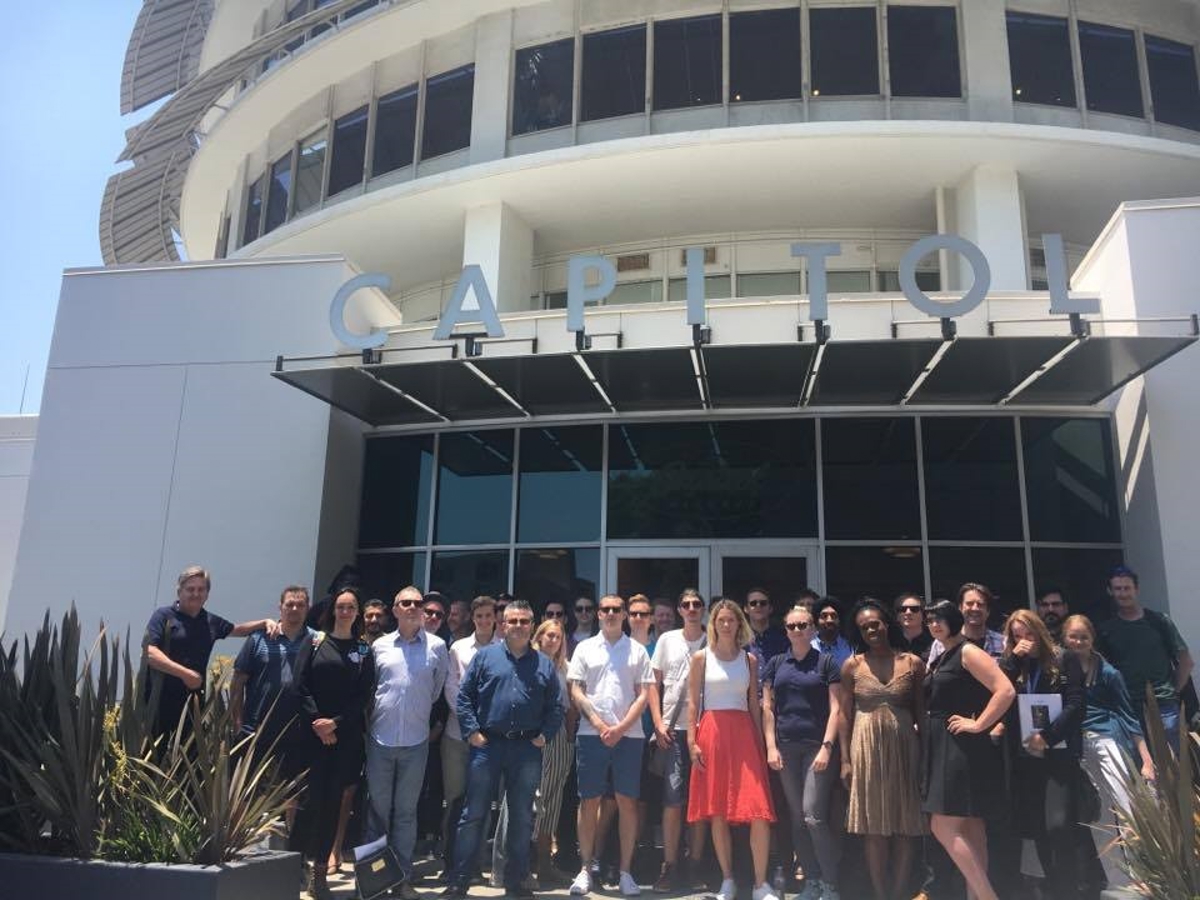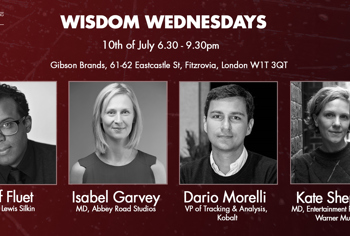The 13th LA Sync Mission, hosted by UK record labels body BPI and the Music Publishers Association (MPA) is taking place all this week in Los Angeles, USA for around 50 delegates drawn mainly from independent labels, music publishers and members of the song-writing community.
The event is organised with the extensive support of the Department for International Trade (DIT) and Music is GREAT and aims to give UK music companies and representatives the chance to learn about ‘sync’1 opportunities in the world’s biggest entertainment media market; to network with key executives; and to license their artists’ work for use in film, TV and games soundtracks and in broadcast advertising.
Held at the iconic Capitol Studios in the heart of Hollywood, the five-day mission is a broad-ranging and dynamic mix of panels, site visits, practical sessions, meetings and keynote speakers, and also includes an exclusive networking reception at the British Consul General’s residence held in honour of the delegates. Highlighting the talent on offer to LA producers and execs, Arts Council England are also supporting the mission by funding2 a showcase for English-based artists, songwriters and composers. This follows on from a song-writing camp held over the weekend in the run up to the mission.
The LA Sync Mission is expected to generate around £2million in revenues for the participating companies – a significant contribution to the value of the UK sync market, estimated to be worth around £80 million3 across the recorded music and music publishing sectors in 2016.
Last year, for example, delegates met with executives responsible for placing music on films that included the Academy Award-winning Spotlight, The Hateful Eight and Fantastic Four, as well as TV shows including Girls, The People vs OJ Simpson, NCIS, Stranger Things, and The Man In The High Castle. They also met with the teams who commissioned the music for games such as Assassins Creed, Forza Horizon 2 and Rainbow 6.
Music Publishers Association CEO Jane Dyball, said: “With the value of sync revenue and direct licensing received by our members in 2016 standing at over £50m, sync is undoubtedly an integral part of the music publishing business. Sync teams continue to grow within our membership and trade missions like the LA Sync Mission provide them with the perfect opportunity to learn more and network with music supervisors and clients. Sync licensing always involves the music publishing rights regardless of whether the original master is used or a new recording is commissioned, but teaming up with our friends at the BPI makes perfect sense. We are also very grateful for the continued support of DIT, in this, our 13th year.”
BPI Director of Independent Membership & International, Chris Tams said: “The music composed for or licensed to film and TV scores, games soundtracks and broadcast ads has become an important element in the global success of British music. Los Angeles – the world’s movie capital – is unquestionably the gateway for sync, not just to the lucrative US market but increasingly to burgeoning international markets also. It makes the BPI’s joint trade mission with MPA and DIT to LA, now in its thirteenth year, more valuable than ever as an unmissable key learning and networking event for our songwriters and artists, labels and publishers, equipping them with the means and insight to understand not only where the commercial opportunities lie, but, crucially, how best to access them.”
The vibrant indie music community plays a full and active part in helping to develop and grow opportunities around sync, and its representatives are a key focus of the LA Sync Mission each year.
Regent Street Records Founder and CEO, Vanessa Higgins, who is also an Independent Label representative on the BPI’s Council, said: "The annual LA Sync Mission is a wonderful opportunity to build relationships and cement business in Hollywood’s lucrative sync market, and this is especially true for indie labels who may not otherwise be able to get these introductions. Both through panels and targeted networking opportunities, the sync mission opens the door to long-term business relationships with music supervisors and also the chance to strengthen ties with other UK based labels, music publishers and musicians. With the rise of streamed TV shows in particular, the need for independent music in sync has never been greater."
Sync boosted by streaming of film, TV & games soundtracks
The sync business can often help to grow other ancillary consumption of music, such as streaming – the music format of choice for many fans – thereby generating more income for artists and the industry. Music used in films, on television and in advertisements often performs well on streaming services.
Such a trend helps to explain why the 1967 Marvin Gaye/Tammi Terrell hit Ain’t No Mountain High Enough, which featured on Guardians of the Galaxy, was the most streamed track of the 1960s in 2016 (10 million plays). ELO’s Mr Blue Sky also benefitted from exposure in the film. Similarly, Creedence Clearwater Revival’s Fortunate Son, which appeared in Suicide Squad, was, with 4.4 million plays, the fifth-most-streamed track in 2016 from 1969.
Another example is provided by Smash Mouth by All Star – entering the Official Charts at just No.24 when it first came out in 1999, its popularity has grown in the meantime, thanks in part to its inclusion on the original soundtrack to Shrek. In 2016 it was one of the most-streamed tracks from the Nineties, played over 11 million times, and was one of the 300 most-streamed tracks of the year.
Video games can also make a significant contribution to sync revenues. Whilst the value of this sector may have dropped from its peak of around 10 years ago when the Guitar Hero, Rock Band and SingStar franchises were at their most popular, revenues are growing once more as soundtracks become an increasingly important part of a game’s appeal. Compositions for the Final Fantasy and Halo series, The Legend of Zelda, Call of Duty, and Elder Scrolls, for example, are sufficiently regarded to have made it into recent Classic FM Halls of Fame. More pertinent to sync perhaps, 2x BRIT Award winner Rag’n’Bone Man’s Human formed the soundtrack to the official trailer to EA BioWare’s video game Mass Effect: Andromeda.
TV & Digital adverting is giving sync a bigger platform / Success of Rag’n’Bone Man’s Human
Broadcast advertising on TV and radio and at the cinema has long been an important platform for sync – a medium now made even more potent by the greater consumer reach offered by digital channels and social media. However, it’s only within the last decade, as vividly highlighted by the landmark success in the UK of the John Lewis Christmas ads that began in 2007, that this potential has been more fully realised to the mutual benefit of consumer brands and music creators alike.
The remarkable success of Rag’n’Bone Man in the last 12 months underlines the considerable scope for sync to help break new artists and raise their profile among the wider public. Rag’n’Bone Man’s single Human was used as the theme to the Amazon Prime series Oasis and featured as background music to numerous TV links and trailers. The exposure will have helped it reach a mainstream audience unfamiliar with the artist and his work – both in the UK and in overseas markets. The marketing campaign incorporated sync into its strategy, perhaps contributing to the success of Human in topping the singles charts in four countries, including Germany, and the album of the same name going to No.1 in five countries, not least the UK, where Human has been certified 2x Platinum by the BPI – representing over 600,000 Album Equivalent Sales (AES).
Adbreakanthems survey reveals British music is most popular for UK advertisers, led by fashion sector
Unique market research by Adbreakanthems Editor-in-Chief Chas de Whalley based on a snapshot of 605 syncs researched and posted on www.adbreakanthems.com in 2016 indicates some fascinating trends.
British artists account for four in 10 of the music syncs used in UK broadcast advertising in 2016 (39.7%) ahead of acts from The US (37.7%), France (5.2%), Australia and Italy (both 2.1%) and Sweden (1.8%).
Among the most synched artists in 2016 was Universal Music act Barns Courtney, who has enjoyed great sync success on both sides of the Atlantic, with music featuring in Harvey Weinstein’s Burnt and his songs Fire and Glitter & Gold used in spots for Burberry, Volkswagen, Sky, Renault, Miller Lite and Taco Bell.
Another Universal Music artist, Jamie N Commons, saw his music synched for a number of ads and trailers, ranging from retailer Littlewoods to the BBC’s Olympics trailer which featured Not Gonna Break Me. Mura Masa’s When U Need Me was placed in advertising for Sonos and Apple, Love Sick helped to promote PrettyLittleThing and What if I Go featured on another Boohoo campaign.
Warner Music acts also featured strongly, including Dua Lipa, whose Be The One and Hotter Than Hell were licensed for Vauxhall Corsa and Boohoo respectively, Birdy, whose song Keeping Your Head Up was used for Sky and Twitter, and Santigold, whose Banshee was used by House of Fraser.
Alongside the sync campaign for Sony Music’s Rag’n’Bone Man – including the trailer for EA Bioware Mass Effect: Andromeda – other acts from the label were heavily synched. Izzy Bizu’s Sweat featured on H&M ads and Megan Trainor & Lunchmoney Lewis’ I Love Me was licensed to Very.co.uk. Classic songs also feature strongly in TV ads, and Sony recording Shining Star by Earth, Wind & Fire’s appeared on Nike ads.
Music licensed through smaller and independent labels and publishers is also thriving. Heritage act James, whose track Nothing But Love is licensed through BMG, helped to power campaigns for both Amazon and the National Lottery. The Black Keys’ Tighten Up, licensed through [PIAS], featured on ads for Samsung, while Warp’s Darkstar provided music for sync for campaigns by Gucci Bamboo and Channel 4 respectively. Danger Twins tracks Radar and Steal the Scene were licensed through Peer Music Productions to Calvin Klein and Lexus respectively, and Mason track Papapapa was licensed to Deezer by Loulou Records.
When assessed by genre, pop was the most in demand, accounting for nearly a fifth of syncs (19%), ahead of alternative (12.7%), orchestral (8.2%), electronica (7.9%) and MOR/easy listening (7.2%). However, R’n’B/soul, hip hop and grime/rap between them accounted for over a tenth (10.4%) of syncs and are a growing category among brands keen to engage younger consumers with cutting-edge marketing.
The two advertising sectors that look most to music syncs are the worlds of Fashion, which accounts for 11.1 per cent of music syncs, and Food and Drink at 10.4 per cent. These are followed by Motoring (8.8%) and Health and Beauty (5.8%). The annual survey also suggests that the music being used in sync is becoming more contemporary (released less than five years ago), perhaps reflecting greater targeting of younger consumers by advertisers. In 2016 a third (33.2%) of the music licensed was contemporary – up 5 percentage points on 2015 (28.6%), while 19.3 per cent was specially commissioned and 18.8 per cent came from deep catalogue (over 20 year old). Catalogue that was between five to 20 years old accounted for 11.6 per cent of syncs, 11.2 per cent were re-records, and 5.8 per cent was drawn from library music.
The music composed for or licensed to film and TV scores, games soundtracks and broadcast ads has become an important element in the global success of British music. Los Angeles – the world’s movie capital – is unquestionably the gateway for sync, not just to the lucrative US market but increasingly to burgeoning international markets also. It makes the BPI’s joint trade mission with MPA and DIT to LA, now in its thirteenth year, more valuable than ever as an unmissable key learning and networking event for our songwriters and artists, labels and publishers, equipping them with the means and insight to understand not only where the commercial opportunities lie, but, crucially, how best to access them.




